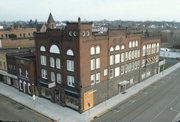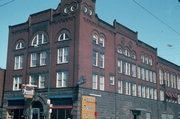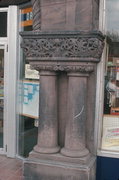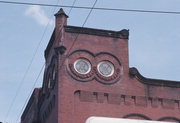| Additional Information: | BROWNSTONE FIRST STORY WITH ENTRY ARCH. INTERIOR LODGE HALL INTACT. STAINED GLASS EMBLEMS OF LODGE IN SQUARE CORNER TURRET WINDOWS. VISUAL LANDMARK IN ASHLAND. FORMER ENTRY AT CORNER WHERE STORE SIGN IS NOW [Date Cnst:(A)]
DESCRIPTION: This large-scale four-story red brick and brownstone Masonic Temple building secures the southwest corner of the West Second Street commercial district as strongly as the Old Post Office, the former First National Bank, and the former Union National Bank secure the other district's three corners. Both the West Second Street and the Sixth avenue West facades have been elaborately articulated by means of arches and brownstone details as well as decorative emblems particular to the Mason's. The primary West Second Street facade is largely unaltered and is dominated by the rusticated central brownstone arch and side piers. The entry arch, in the Richardsonian Romanesque manner, features foliated capitols over paired colonettes, and a massive keystone. The character of this entry arch compares well to the respective arch on the Old Post Office, (#1),or what was once in place on the First National Bank building. The three part facade is continued on the second and third floors by coupled rectangular 1/1 double sash windows, each pair with continuous brownstone sills and lintels. The central windows are separated by a brick pier with a brownstone base and capital, thus emphasizing this centralized grouping. This treatment continues on the next floor, where three semicircular grouping. This treatment continues on the net floor, where the three semicircular arched windows are now covered by wood panels. Red brick voussoirs and brownstone archivolt moldings surround the two-and-three-part windows. Above the larger central arch is a stylishly carved brownstone panel wth the building's name cut in Art Nouveau style letters. Side piers rise to join the projecting corbel table enriched by the brownstone coping that meets with S-and C-scrolls the corner tower. This stubby tower features the original circular paired stained-glass windows with the Masonic emblems depicted and resembles the tower on the Grand Opera House (#16). The Sixth Avenue West facade is much longer and repeats many of the primary facade's features including the massive rock-faced brownstone ground floor, the rectangular windows with continuous brownstone sills and lintels and, finally, both tripled and coupled semicircular arched windows with red brick voussiors and brownstone archivolt moldings. The asymmetrical fenestration is grouped by the three major facade divisions whose upper entablatures feature brick corbel tables small rectangular colonettes and brownstone coping. The building's primary stylistic emphasis is in the Richardonian Romanesque manner, with additional medievalizing features. Alterations on this west facade include the enclosure of arched windows on the ground floor and the removal of two entries one minor and one major. The missing major entry was a basement doorway which was located at the foremost corner, where the pharmacy sign is now attached.
SIGNIFICANCE: This building is considered pivotal at this corner of the district and ranks in quality of design and craftsmanship with other pivotal district properties such as the Old Post Office (#1), the Northern State Bank (#17), the First National Bank (#30), the Security Savings Bank (#40), or the Vaughn Block (#11). It is significant, moreover, as a downtown visual landmark, and like the other pivotal buildings at the three other corners of the district, the Masonic Temple and Hall is visible from many points in Ashland outside the district. The Old Post Office and the Masonic Temple and Hall are very decisive terminus buildings for the west end of the commercial district. The Masonic Temple is believed by many to be the most beautiful building in Ashland of this polychromatic Richardsonian Romanesque style, which is enhanced by the brownstone capitols, finely carved in a Sullivanesque manner. The Masonic Temple is still active today and retains is remarkably well crafted meeting hall, decorated with massive oak Neo-Classical style walls. Historically, the Masonic Lodge in Ashland has had most of the City's prominent civic and business leaders as members, such as Samuel Vaughn, Sam Fifield, Edwin Ellis or Thomas Bardon. |
|---|





